Impact of HCI on User's Perception: A Research Report Analysis
VerifiedAdded on 2023/04/21
|12
|2697
|439
Report
AI Summary
This report investigates the impact of Human-Computer Interaction (HCI) on user perception, examining its influence across different demographics such as gender, age, cultural background, and working status. The study explores the evolution of HCI, from early Man-Machine Interfaces to modern UX, and discusses the role of design elements like skeumorphism and simplistic interfaces. The research aims to determine whether HCI is designed for time efficiency or time well spent, considering perspectives from industry leaders and user feedback. The methodology involves an exploratory research design with a quantitative approach, utilizing surveys and statistical analysis to assess the impact of HCI on user perception and identify key factors influencing user experience. The report also includes a Gantt chart, risk identification, ethical considerations, and technological requirements.
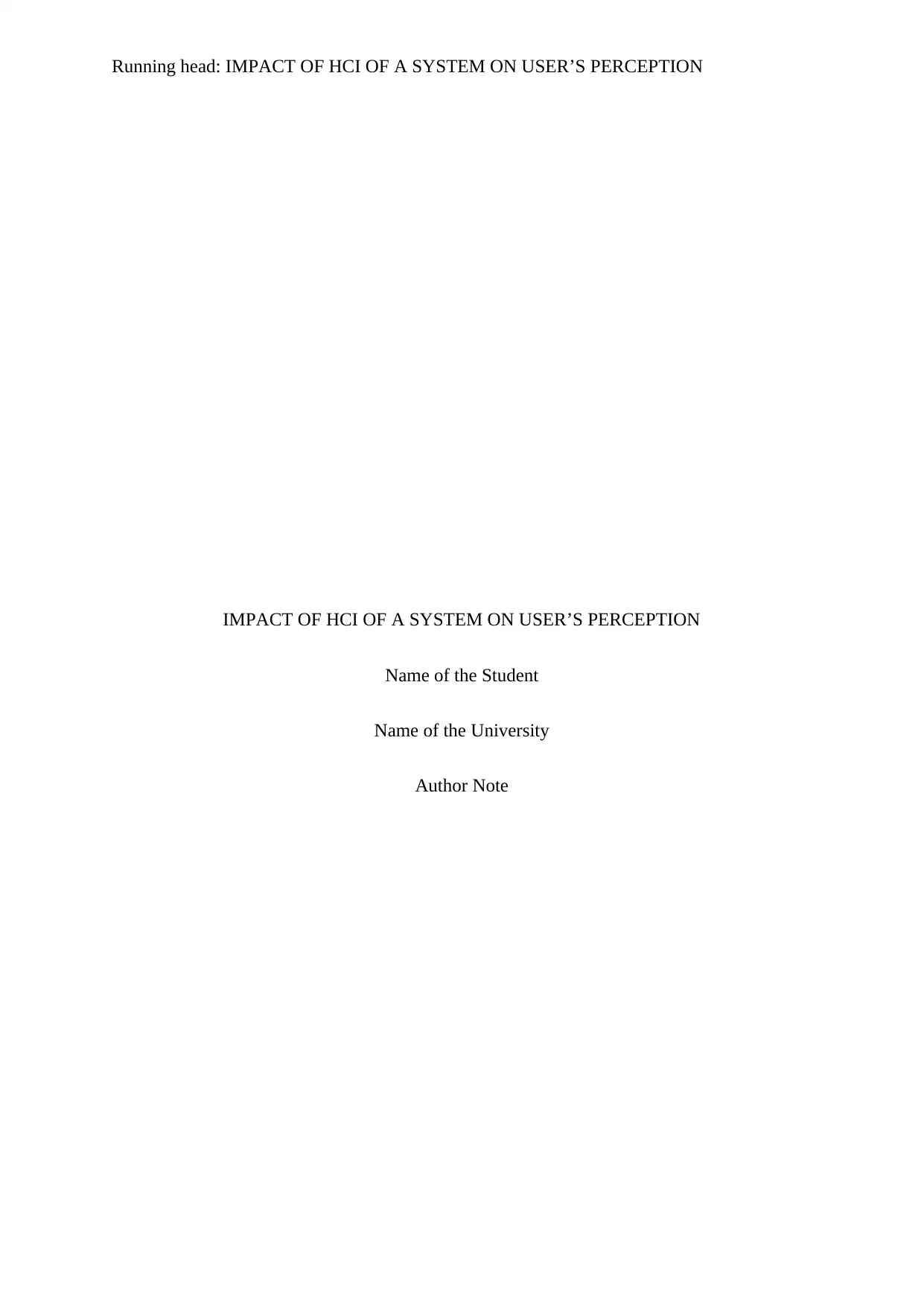
Running head: IMPACT OF HCI OF A SYSTEM ON USER’S PERCEPTION
IMPACT OF HCI OF A SYSTEM ON USER’S PERCEPTION
Name of the Student
Name of the University
Author Note
IMPACT OF HCI OF A SYSTEM ON USER’S PERCEPTION
Name of the Student
Name of the University
Author Note
Paraphrase This Document
Need a fresh take? Get an instant paraphrase of this document with our AI Paraphraser
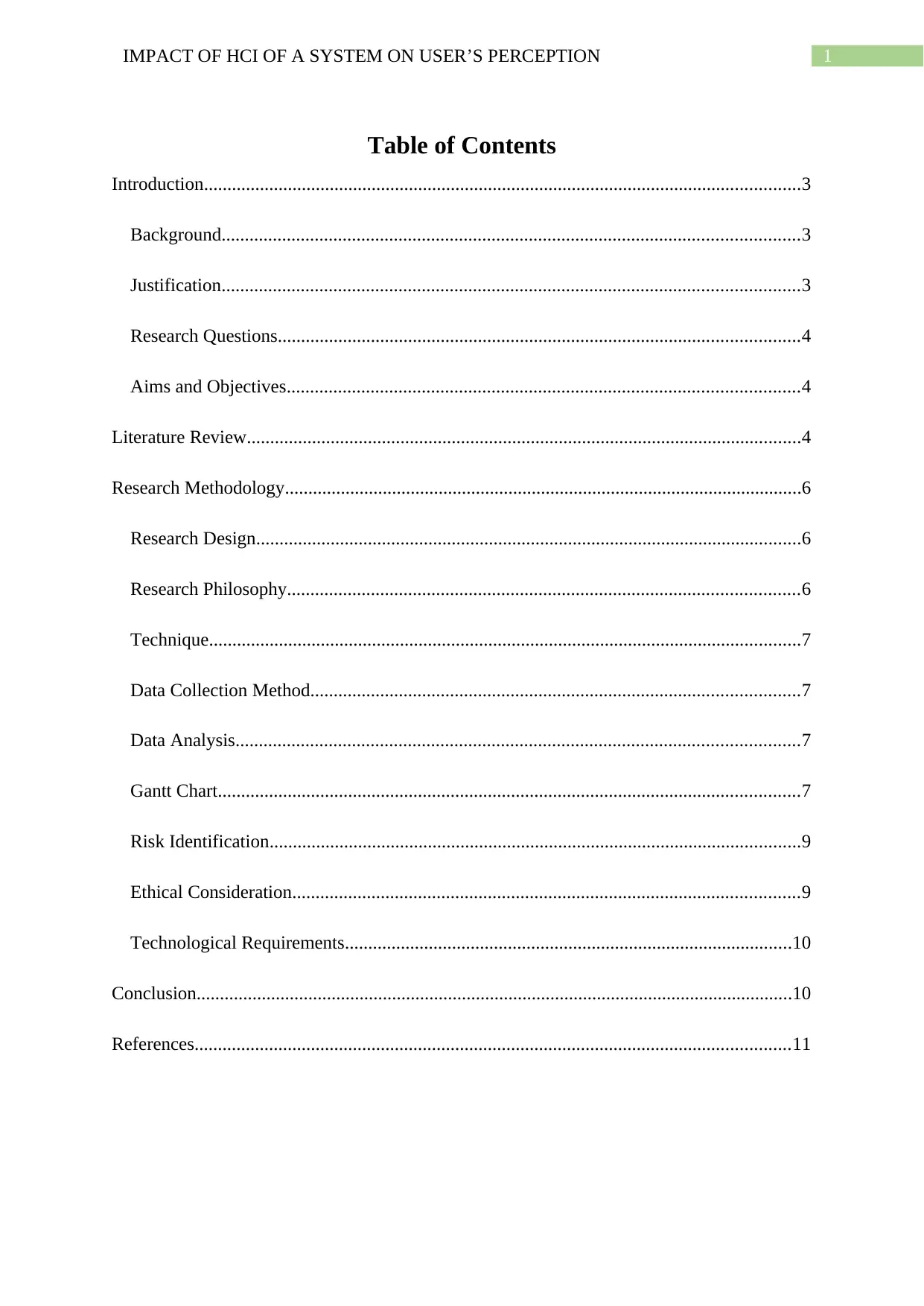
1IMPACT OF HCI OF A SYSTEM ON USER’S PERCEPTION
Table of Contents
Introduction................................................................................................................................3
Background............................................................................................................................3
Justification............................................................................................................................3
Research Questions................................................................................................................4
Aims and Objectives..............................................................................................................4
Literature Review.......................................................................................................................4
Research Methodology...............................................................................................................6
Research Design.....................................................................................................................6
Research Philosophy..............................................................................................................6
Technique...............................................................................................................................7
Data Collection Method.........................................................................................................7
Data Analysis.........................................................................................................................7
Gantt Chart.............................................................................................................................7
Risk Identification..................................................................................................................9
Ethical Consideration.............................................................................................................9
Technological Requirements................................................................................................10
Conclusion................................................................................................................................10
References................................................................................................................................11
Table of Contents
Introduction................................................................................................................................3
Background............................................................................................................................3
Justification............................................................................................................................3
Research Questions................................................................................................................4
Aims and Objectives..............................................................................................................4
Literature Review.......................................................................................................................4
Research Methodology...............................................................................................................6
Research Design.....................................................................................................................6
Research Philosophy..............................................................................................................6
Technique...............................................................................................................................7
Data Collection Method.........................................................................................................7
Data Analysis.........................................................................................................................7
Gantt Chart.............................................................................................................................7
Risk Identification..................................................................................................................9
Ethical Consideration.............................................................................................................9
Technological Requirements................................................................................................10
Conclusion................................................................................................................................10
References................................................................................................................................11

2IMPACT OF HCI OF A SYSTEM ON USER’S PERCEPTION
⊘ This is a preview!⊘
Do you want full access?
Subscribe today to unlock all pages.

Trusted by 1+ million students worldwide
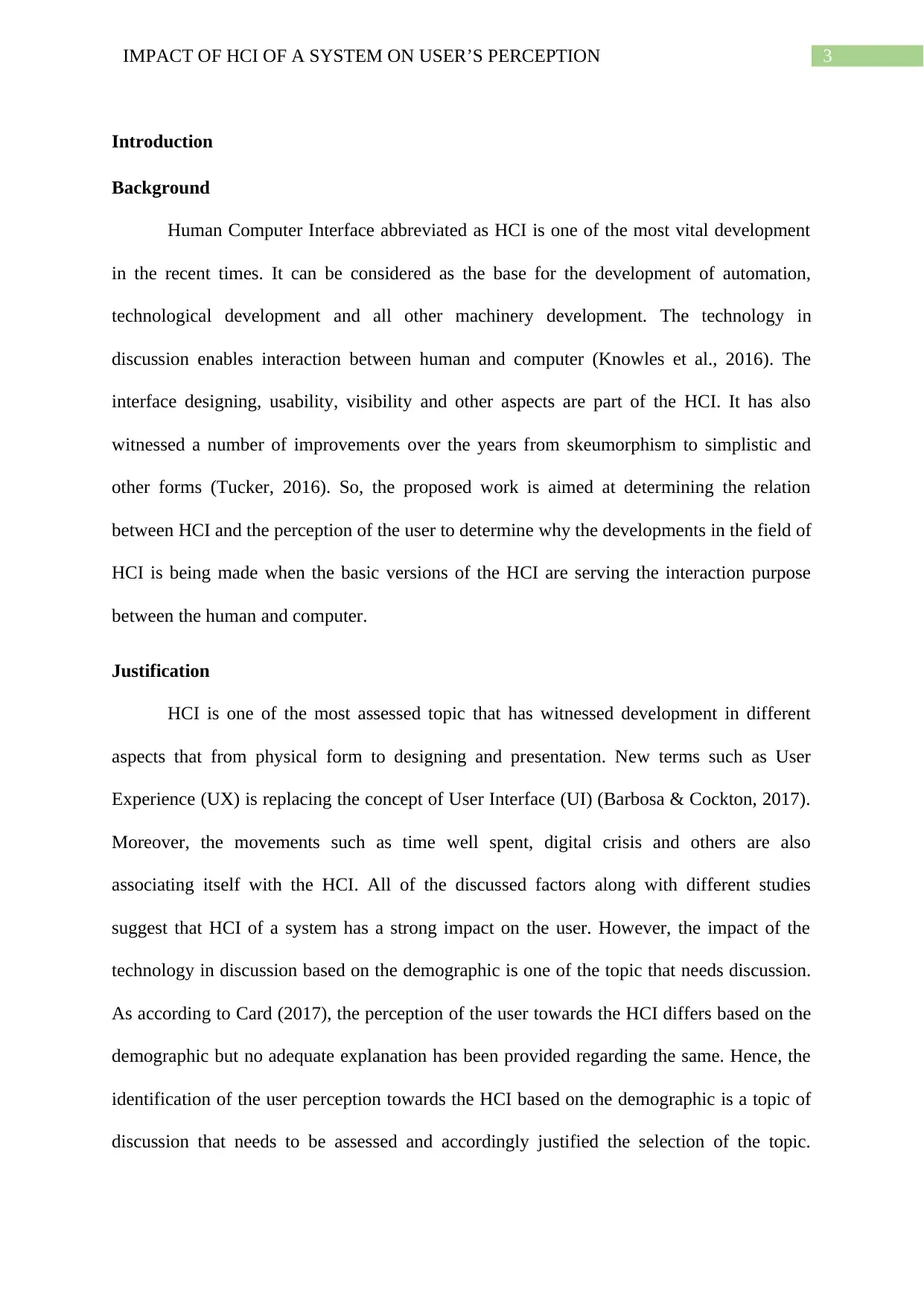
3IMPACT OF HCI OF A SYSTEM ON USER’S PERCEPTION
Introduction
Background
Human Computer Interface abbreviated as HCI is one of the most vital development
in the recent times. It can be considered as the base for the development of automation,
technological development and all other machinery development. The technology in
discussion enables interaction between human and computer (Knowles et al., 2016). The
interface designing, usability, visibility and other aspects are part of the HCI. It has also
witnessed a number of improvements over the years from skeumorphism to simplistic and
other forms (Tucker, 2016). So, the proposed work is aimed at determining the relation
between HCI and the perception of the user to determine why the developments in the field of
HCI is being made when the basic versions of the HCI are serving the interaction purpose
between the human and computer.
Justification
HCI is one of the most assessed topic that has witnessed development in different
aspects that from physical form to designing and presentation. New terms such as User
Experience (UX) is replacing the concept of User Interface (UI) (Barbosa & Cockton, 2017).
Moreover, the movements such as time well spent, digital crisis and others are also
associating itself with the HCI. All of the discussed factors along with different studies
suggest that HCI of a system has a strong impact on the user. However, the impact of the
technology in discussion based on the demographic is one of the topic that needs discussion.
As according to Card (2017), the perception of the user towards the HCI differs based on the
demographic but no adequate explanation has been provided regarding the same. Hence, the
identification of the user perception towards the HCI based on the demographic is a topic of
discussion that needs to be assessed and accordingly justified the selection of the topic.
Introduction
Background
Human Computer Interface abbreviated as HCI is one of the most vital development
in the recent times. It can be considered as the base for the development of automation,
technological development and all other machinery development. The technology in
discussion enables interaction between human and computer (Knowles et al., 2016). The
interface designing, usability, visibility and other aspects are part of the HCI. It has also
witnessed a number of improvements over the years from skeumorphism to simplistic and
other forms (Tucker, 2016). So, the proposed work is aimed at determining the relation
between HCI and the perception of the user to determine why the developments in the field of
HCI is being made when the basic versions of the HCI are serving the interaction purpose
between the human and computer.
Justification
HCI is one of the most assessed topic that has witnessed development in different
aspects that from physical form to designing and presentation. New terms such as User
Experience (UX) is replacing the concept of User Interface (UI) (Barbosa & Cockton, 2017).
Moreover, the movements such as time well spent, digital crisis and others are also
associating itself with the HCI. All of the discussed factors along with different studies
suggest that HCI of a system has a strong impact on the user. However, the impact of the
technology in discussion based on the demographic is one of the topic that needs discussion.
As according to Card (2017), the perception of the user towards the HCI differs based on the
demographic but no adequate explanation has been provided regarding the same. Hence, the
identification of the user perception towards the HCI based on the demographic is a topic of
discussion that needs to be assessed and accordingly justified the selection of the topic.
Paraphrase This Document
Need a fresh take? Get an instant paraphrase of this document with our AI Paraphraser
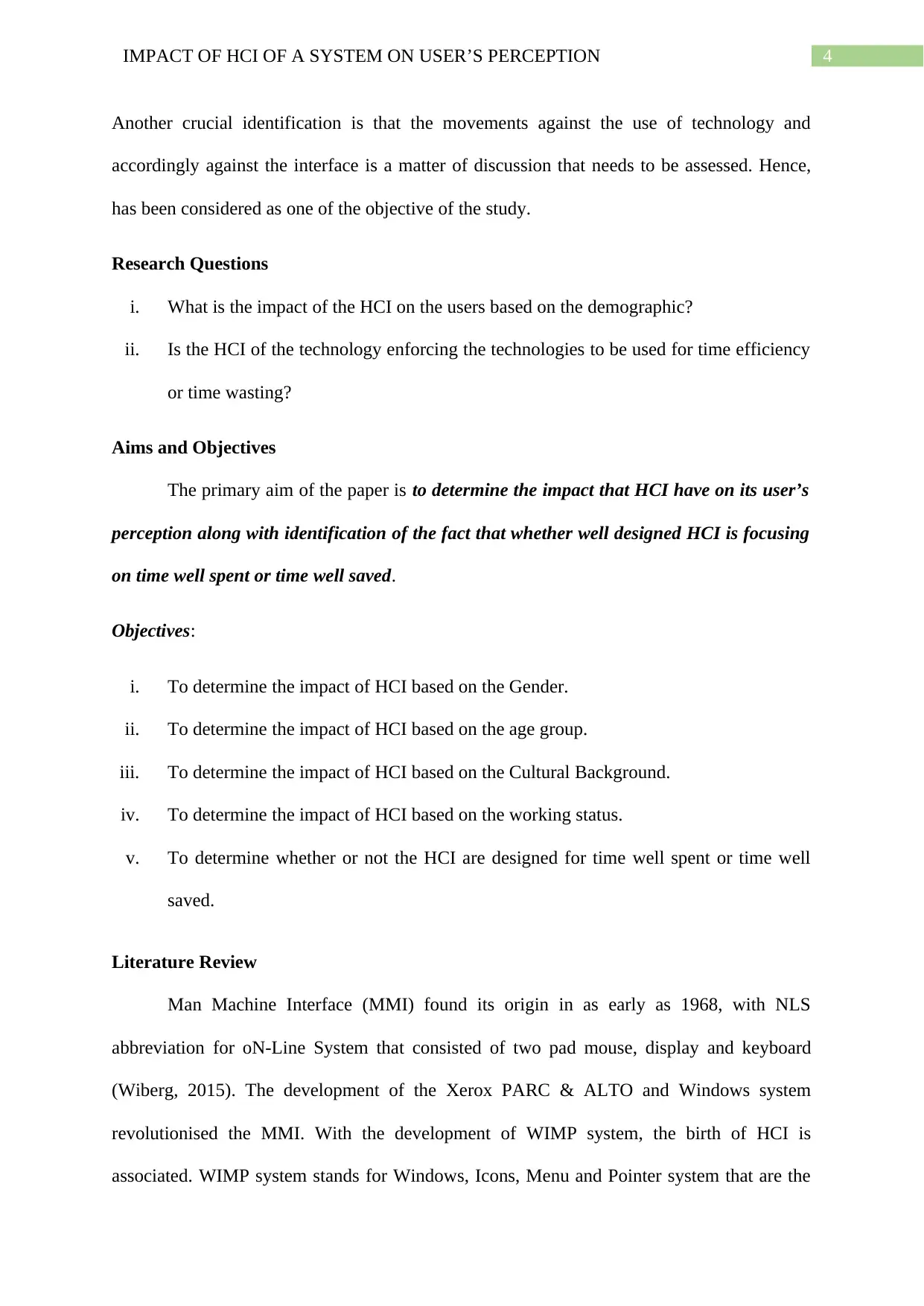
4IMPACT OF HCI OF A SYSTEM ON USER’S PERCEPTION
Another crucial identification is that the movements against the use of technology and
accordingly against the interface is a matter of discussion that needs to be assessed. Hence,
has been considered as one of the objective of the study.
Research Questions
i. What is the impact of the HCI on the users based on the demographic?
ii. Is the HCI of the technology enforcing the technologies to be used for time efficiency
or time wasting?
Aims and Objectives
The primary aim of the paper is to determine the impact that HCI have on its user’s
perception along with identification of the fact that whether well designed HCI is focusing
on time well spent or time well saved.
Objectives:
i. To determine the impact of HCI based on the Gender.
ii. To determine the impact of HCI based on the age group.
iii. To determine the impact of HCI based on the Cultural Background.
iv. To determine the impact of HCI based on the working status.
v. To determine whether or not the HCI are designed for time well spent or time well
saved.
Literature Review
Man Machine Interface (MMI) found its origin in as early as 1968, with NLS
abbreviation for oN-Line System that consisted of two pad mouse, display and keyboard
(Wiberg, 2015). The development of the Xerox PARC & ALTO and Windows system
revolutionised the MMI. With the development of WIMP system, the birth of HCI is
associated. WIMP system stands for Windows, Icons, Menu and Pointer system that are the
Another crucial identification is that the movements against the use of technology and
accordingly against the interface is a matter of discussion that needs to be assessed. Hence,
has been considered as one of the objective of the study.
Research Questions
i. What is the impact of the HCI on the users based on the demographic?
ii. Is the HCI of the technology enforcing the technologies to be used for time efficiency
or time wasting?
Aims and Objectives
The primary aim of the paper is to determine the impact that HCI have on its user’s
perception along with identification of the fact that whether well designed HCI is focusing
on time well spent or time well saved.
Objectives:
i. To determine the impact of HCI based on the Gender.
ii. To determine the impact of HCI based on the age group.
iii. To determine the impact of HCI based on the Cultural Background.
iv. To determine the impact of HCI based on the working status.
v. To determine whether or not the HCI are designed for time well spent or time well
saved.
Literature Review
Man Machine Interface (MMI) found its origin in as early as 1968, with NLS
abbreviation for oN-Line System that consisted of two pad mouse, display and keyboard
(Wiberg, 2015). The development of the Xerox PARC & ALTO and Windows system
revolutionised the MMI. With the development of WIMP system, the birth of HCI is
associated. WIMP system stands for Windows, Icons, Menu and Pointer system that are the
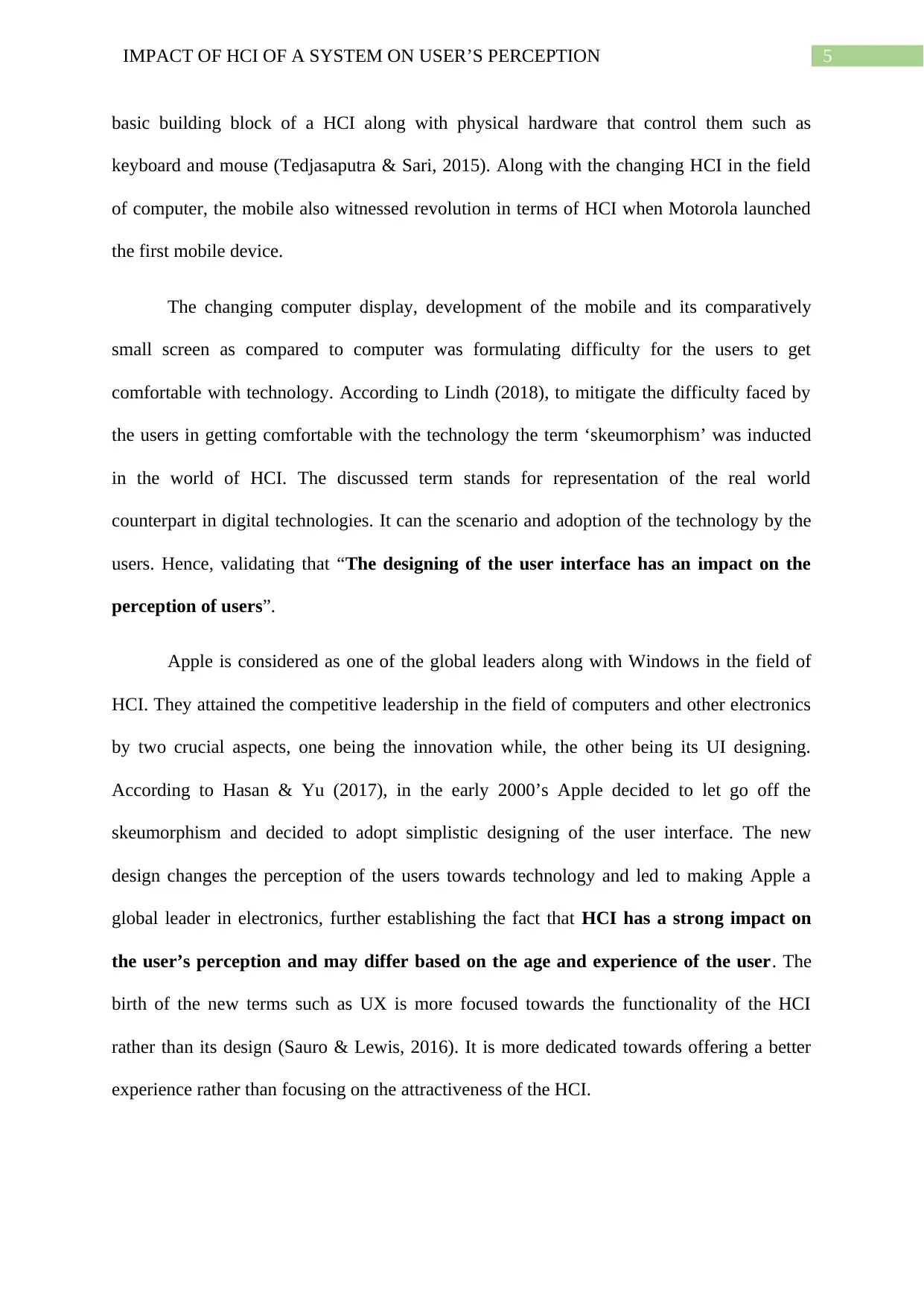
5IMPACT OF HCI OF A SYSTEM ON USER’S PERCEPTION
basic building block of a HCI along with physical hardware that control them such as
keyboard and mouse (Tedjasaputra & Sari, 2015). Along with the changing HCI in the field
of computer, the mobile also witnessed revolution in terms of HCI when Motorola launched
the first mobile device.
The changing computer display, development of the mobile and its comparatively
small screen as compared to computer was formulating difficulty for the users to get
comfortable with technology. According to Lindh (2018), to mitigate the difficulty faced by
the users in getting comfortable with the technology the term ‘skeumorphism’ was inducted
in the world of HCI. The discussed term stands for representation of the real world
counterpart in digital technologies. It can the scenario and adoption of the technology by the
users. Hence, validating that “The designing of the user interface has an impact on the
perception of users”.
Apple is considered as one of the global leaders along with Windows in the field of
HCI. They attained the competitive leadership in the field of computers and other electronics
by two crucial aspects, one being the innovation while, the other being its UI designing.
According to Hasan & Yu (2017), in the early 2000’s Apple decided to let go off the
skeumorphism and decided to adopt simplistic designing of the user interface. The new
design changes the perception of the users towards technology and led to making Apple a
global leader in electronics, further establishing the fact that HCI has a strong impact on
the user’s perception and may differ based on the age and experience of the user. The
birth of the new terms such as UX is more focused towards the functionality of the HCI
rather than its design (Sauro & Lewis, 2016). It is more dedicated towards offering a better
experience rather than focusing on the attractiveness of the HCI.
basic building block of a HCI along with physical hardware that control them such as
keyboard and mouse (Tedjasaputra & Sari, 2015). Along with the changing HCI in the field
of computer, the mobile also witnessed revolution in terms of HCI when Motorola launched
the first mobile device.
The changing computer display, development of the mobile and its comparatively
small screen as compared to computer was formulating difficulty for the users to get
comfortable with technology. According to Lindh (2018), to mitigate the difficulty faced by
the users in getting comfortable with the technology the term ‘skeumorphism’ was inducted
in the world of HCI. The discussed term stands for representation of the real world
counterpart in digital technologies. It can the scenario and adoption of the technology by the
users. Hence, validating that “The designing of the user interface has an impact on the
perception of users”.
Apple is considered as one of the global leaders along with Windows in the field of
HCI. They attained the competitive leadership in the field of computers and other electronics
by two crucial aspects, one being the innovation while, the other being its UI designing.
According to Hasan & Yu (2017), in the early 2000’s Apple decided to let go off the
skeumorphism and decided to adopt simplistic designing of the user interface. The new
design changes the perception of the users towards technology and led to making Apple a
global leader in electronics, further establishing the fact that HCI has a strong impact on
the user’s perception and may differ based on the age and experience of the user. The
birth of the new terms such as UX is more focused towards the functionality of the HCI
rather than its design (Sauro & Lewis, 2016). It is more dedicated towards offering a better
experience rather than focusing on the attractiveness of the HCI.
⊘ This is a preview!⊘
Do you want full access?
Subscribe today to unlock all pages.

Trusted by 1+ million students worldwide
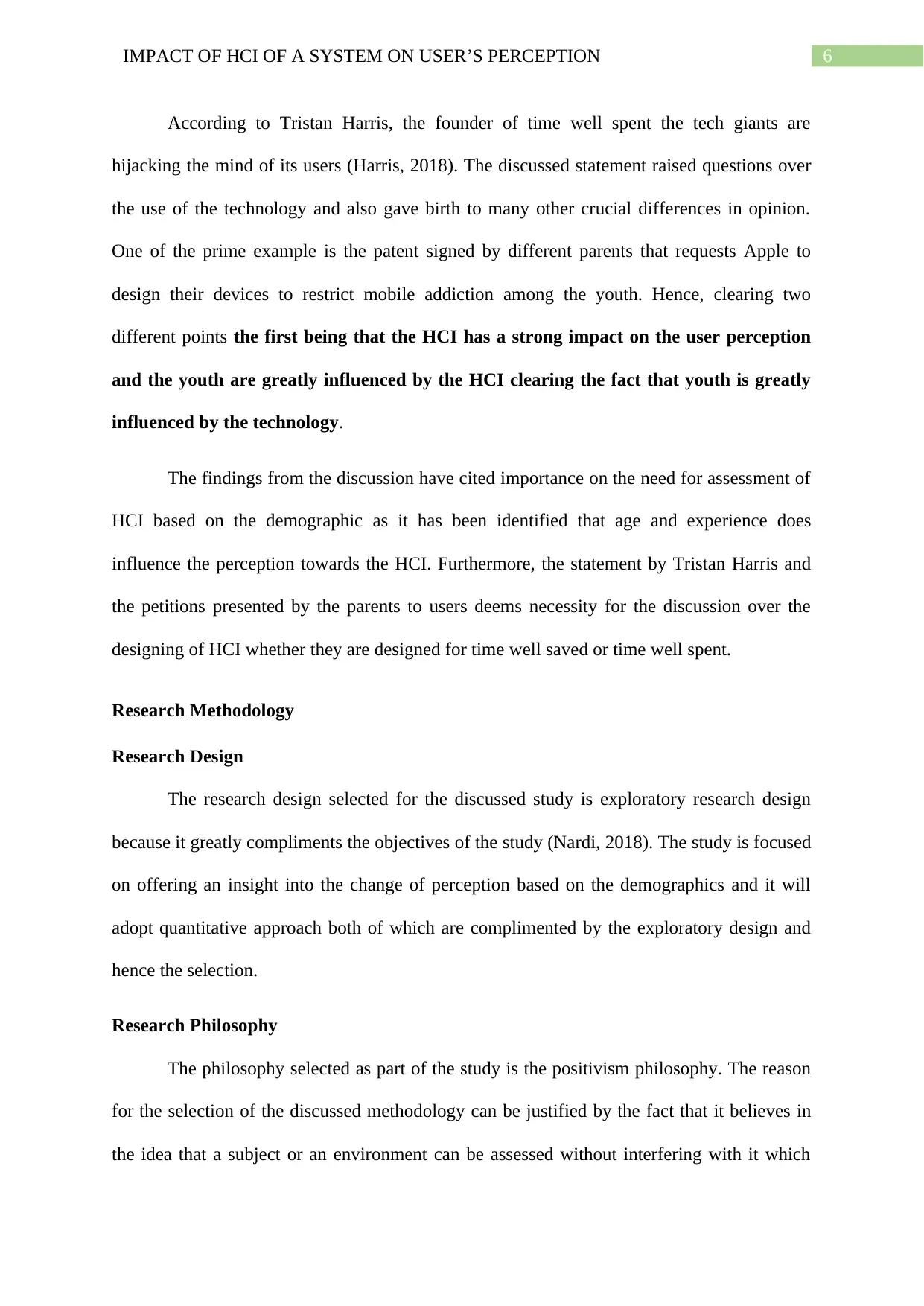
6IMPACT OF HCI OF A SYSTEM ON USER’S PERCEPTION
According to Tristan Harris, the founder of time well spent the tech giants are
hijacking the mind of its users (Harris, 2018). The discussed statement raised questions over
the use of the technology and also gave birth to many other crucial differences in opinion.
One of the prime example is the patent signed by different parents that requests Apple to
design their devices to restrict mobile addiction among the youth. Hence, clearing two
different points the first being that the HCI has a strong impact on the user perception
and the youth are greatly influenced by the HCI clearing the fact that youth is greatly
influenced by the technology.
The findings from the discussion have cited importance on the need for assessment of
HCI based on the demographic as it has been identified that age and experience does
influence the perception towards the HCI. Furthermore, the statement by Tristan Harris and
the petitions presented by the parents to users deems necessity for the discussion over the
designing of HCI whether they are designed for time well saved or time well spent.
Research Methodology
Research Design
The research design selected for the discussed study is exploratory research design
because it greatly compliments the objectives of the study (Nardi, 2018). The study is focused
on offering an insight into the change of perception based on the demographics and it will
adopt quantitative approach both of which are complimented by the exploratory design and
hence the selection.
Research Philosophy
The philosophy selected as part of the study is the positivism philosophy. The reason
for the selection of the discussed methodology can be justified by the fact that it believes in
the idea that a subject or an environment can be assessed without interfering with it which
According to Tristan Harris, the founder of time well spent the tech giants are
hijacking the mind of its users (Harris, 2018). The discussed statement raised questions over
the use of the technology and also gave birth to many other crucial differences in opinion.
One of the prime example is the patent signed by different parents that requests Apple to
design their devices to restrict mobile addiction among the youth. Hence, clearing two
different points the first being that the HCI has a strong impact on the user perception
and the youth are greatly influenced by the HCI clearing the fact that youth is greatly
influenced by the technology.
The findings from the discussion have cited importance on the need for assessment of
HCI based on the demographic as it has been identified that age and experience does
influence the perception towards the HCI. Furthermore, the statement by Tristan Harris and
the petitions presented by the parents to users deems necessity for the discussion over the
designing of HCI whether they are designed for time well saved or time well spent.
Research Methodology
Research Design
The research design selected for the discussed study is exploratory research design
because it greatly compliments the objectives of the study (Nardi, 2018). The study is focused
on offering an insight into the change of perception based on the demographics and it will
adopt quantitative approach both of which are complimented by the exploratory design and
hence the selection.
Research Philosophy
The philosophy selected as part of the study is the positivism philosophy. The reason
for the selection of the discussed methodology can be justified by the fact that it believes in
the idea that a subject or an environment can be assessed without interfering with it which
Paraphrase This Document
Need a fresh take? Get an instant paraphrase of this document with our AI Paraphraser
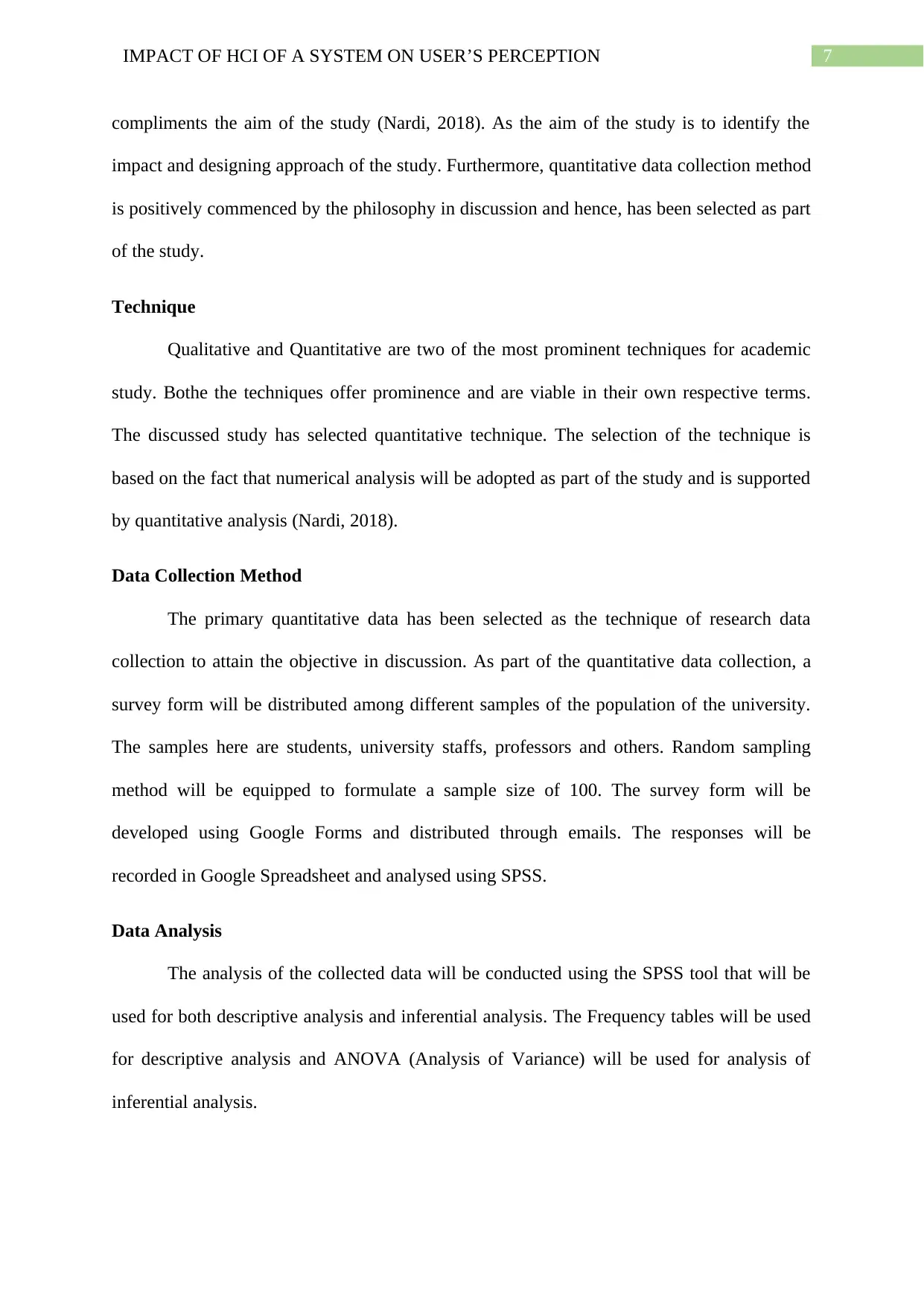
7IMPACT OF HCI OF A SYSTEM ON USER’S PERCEPTION
compliments the aim of the study (Nardi, 2018). As the aim of the study is to identify the
impact and designing approach of the study. Furthermore, quantitative data collection method
is positively commenced by the philosophy in discussion and hence, has been selected as part
of the study.
Technique
Qualitative and Quantitative are two of the most prominent techniques for academic
study. Bothe the techniques offer prominence and are viable in their own respective terms.
The discussed study has selected quantitative technique. The selection of the technique is
based on the fact that numerical analysis will be adopted as part of the study and is supported
by quantitative analysis (Nardi, 2018).
Data Collection Method
The primary quantitative data has been selected as the technique of research data
collection to attain the objective in discussion. As part of the quantitative data collection, a
survey form will be distributed among different samples of the population of the university.
The samples here are students, university staffs, professors and others. Random sampling
method will be equipped to formulate a sample size of 100. The survey form will be
developed using Google Forms and distributed through emails. The responses will be
recorded in Google Spreadsheet and analysed using SPSS.
Data Analysis
The analysis of the collected data will be conducted using the SPSS tool that will be
used for both descriptive analysis and inferential analysis. The Frequency tables will be used
for descriptive analysis and ANOVA (Analysis of Variance) will be used for analysis of
inferential analysis.
compliments the aim of the study (Nardi, 2018). As the aim of the study is to identify the
impact and designing approach of the study. Furthermore, quantitative data collection method
is positively commenced by the philosophy in discussion and hence, has been selected as part
of the study.
Technique
Qualitative and Quantitative are two of the most prominent techniques for academic
study. Bothe the techniques offer prominence and are viable in their own respective terms.
The discussed study has selected quantitative technique. The selection of the technique is
based on the fact that numerical analysis will be adopted as part of the study and is supported
by quantitative analysis (Nardi, 2018).
Data Collection Method
The primary quantitative data has been selected as the technique of research data
collection to attain the objective in discussion. As part of the quantitative data collection, a
survey form will be distributed among different samples of the population of the university.
The samples here are students, university staffs, professors and others. Random sampling
method will be equipped to formulate a sample size of 100. The survey form will be
developed using Google Forms and distributed through emails. The responses will be
recorded in Google Spreadsheet and analysed using SPSS.
Data Analysis
The analysis of the collected data will be conducted using the SPSS tool that will be
used for both descriptive analysis and inferential analysis. The Frequency tables will be used
for descriptive analysis and ANOVA (Analysis of Variance) will be used for analysis of
inferential analysis.
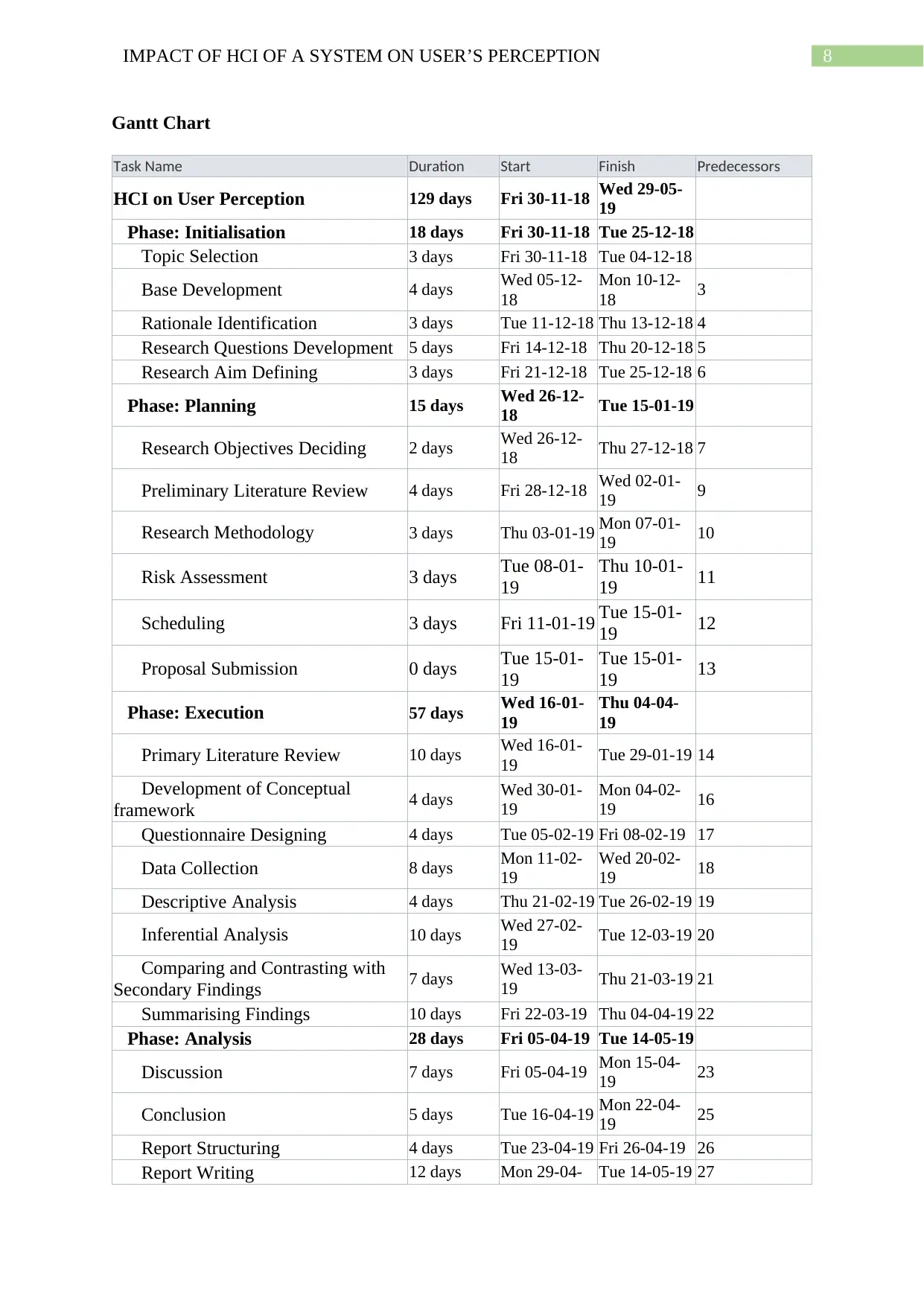
8IMPACT OF HCI OF A SYSTEM ON USER’S PERCEPTION
Gantt Chart
Task Name Duration Start Finish Predecessors
HCI on User Perception 129 days Fri 30-11-18 Wed 29-05-
19
Phase: Initialisation 18 days Fri 30-11-18 Tue 25-12-18
Topic Selection 3 days Fri 30-11-18 Tue 04-12-18
Base Development 4 days Wed 05-12-
18
Mon 10-12-
18 3
Rationale Identification 3 days Tue 11-12-18 Thu 13-12-18 4
Research Questions Development 5 days Fri 14-12-18 Thu 20-12-18 5
Research Aim Defining 3 days Fri 21-12-18 Tue 25-12-18 6
Phase: Planning 15 days Wed 26-12-
18 Tue 15-01-19
Research Objectives Deciding 2 days Wed 26-12-
18 Thu 27-12-18 7
Preliminary Literature Review 4 days Fri 28-12-18 Wed 02-01-
19 9
Research Methodology 3 days Thu 03-01-19 Mon 07-01-
19 10
Risk Assessment 3 days Tue 08-01-
19
Thu 10-01-
19 11
Scheduling 3 days Fri 11-01-19 Tue 15-01-
19 12
Proposal Submission 0 days Tue 15-01-
19
Tue 15-01-
19 13
Phase: Execution 57 days Wed 16-01-
19
Thu 04-04-
19
Primary Literature Review 10 days Wed 16-01-
19 Tue 29-01-19 14
Development of Conceptual
framework 4 days Wed 30-01-
19
Mon 04-02-
19 16
Questionnaire Designing 4 days Tue 05-02-19 Fri 08-02-19 17
Data Collection 8 days Mon 11-02-
19
Wed 20-02-
19 18
Descriptive Analysis 4 days Thu 21-02-19 Tue 26-02-19 19
Inferential Analysis 10 days Wed 27-02-
19 Tue 12-03-19 20
Comparing and Contrasting with
Secondary Findings 7 days Wed 13-03-
19 Thu 21-03-19 21
Summarising Findings 10 days Fri 22-03-19 Thu 04-04-19 22
Phase: Analysis 28 days Fri 05-04-19 Tue 14-05-19
Discussion 7 days Fri 05-04-19 Mon 15-04-
19 23
Conclusion 5 days Tue 16-04-19 Mon 22-04-
19 25
Report Structuring 4 days Tue 23-04-19 Fri 26-04-19 26
Report Writing 12 days Mon 29-04- Tue 14-05-19 27
Gantt Chart
Task Name Duration Start Finish Predecessors
HCI on User Perception 129 days Fri 30-11-18 Wed 29-05-
19
Phase: Initialisation 18 days Fri 30-11-18 Tue 25-12-18
Topic Selection 3 days Fri 30-11-18 Tue 04-12-18
Base Development 4 days Wed 05-12-
18
Mon 10-12-
18 3
Rationale Identification 3 days Tue 11-12-18 Thu 13-12-18 4
Research Questions Development 5 days Fri 14-12-18 Thu 20-12-18 5
Research Aim Defining 3 days Fri 21-12-18 Tue 25-12-18 6
Phase: Planning 15 days Wed 26-12-
18 Tue 15-01-19
Research Objectives Deciding 2 days Wed 26-12-
18 Thu 27-12-18 7
Preliminary Literature Review 4 days Fri 28-12-18 Wed 02-01-
19 9
Research Methodology 3 days Thu 03-01-19 Mon 07-01-
19 10
Risk Assessment 3 days Tue 08-01-
19
Thu 10-01-
19 11
Scheduling 3 days Fri 11-01-19 Tue 15-01-
19 12
Proposal Submission 0 days Tue 15-01-
19
Tue 15-01-
19 13
Phase: Execution 57 days Wed 16-01-
19
Thu 04-04-
19
Primary Literature Review 10 days Wed 16-01-
19 Tue 29-01-19 14
Development of Conceptual
framework 4 days Wed 30-01-
19
Mon 04-02-
19 16
Questionnaire Designing 4 days Tue 05-02-19 Fri 08-02-19 17
Data Collection 8 days Mon 11-02-
19
Wed 20-02-
19 18
Descriptive Analysis 4 days Thu 21-02-19 Tue 26-02-19 19
Inferential Analysis 10 days Wed 27-02-
19 Tue 12-03-19 20
Comparing and Contrasting with
Secondary Findings 7 days Wed 13-03-
19 Thu 21-03-19 21
Summarising Findings 10 days Fri 22-03-19 Thu 04-04-19 22
Phase: Analysis 28 days Fri 05-04-19 Tue 14-05-19
Discussion 7 days Fri 05-04-19 Mon 15-04-
19 23
Conclusion 5 days Tue 16-04-19 Mon 22-04-
19 25
Report Structuring 4 days Tue 23-04-19 Fri 26-04-19 26
Report Writing 12 days Mon 29-04- Tue 14-05-19 27
⊘ This is a preview!⊘
Do you want full access?
Subscribe today to unlock all pages.

Trusted by 1+ million students worldwide
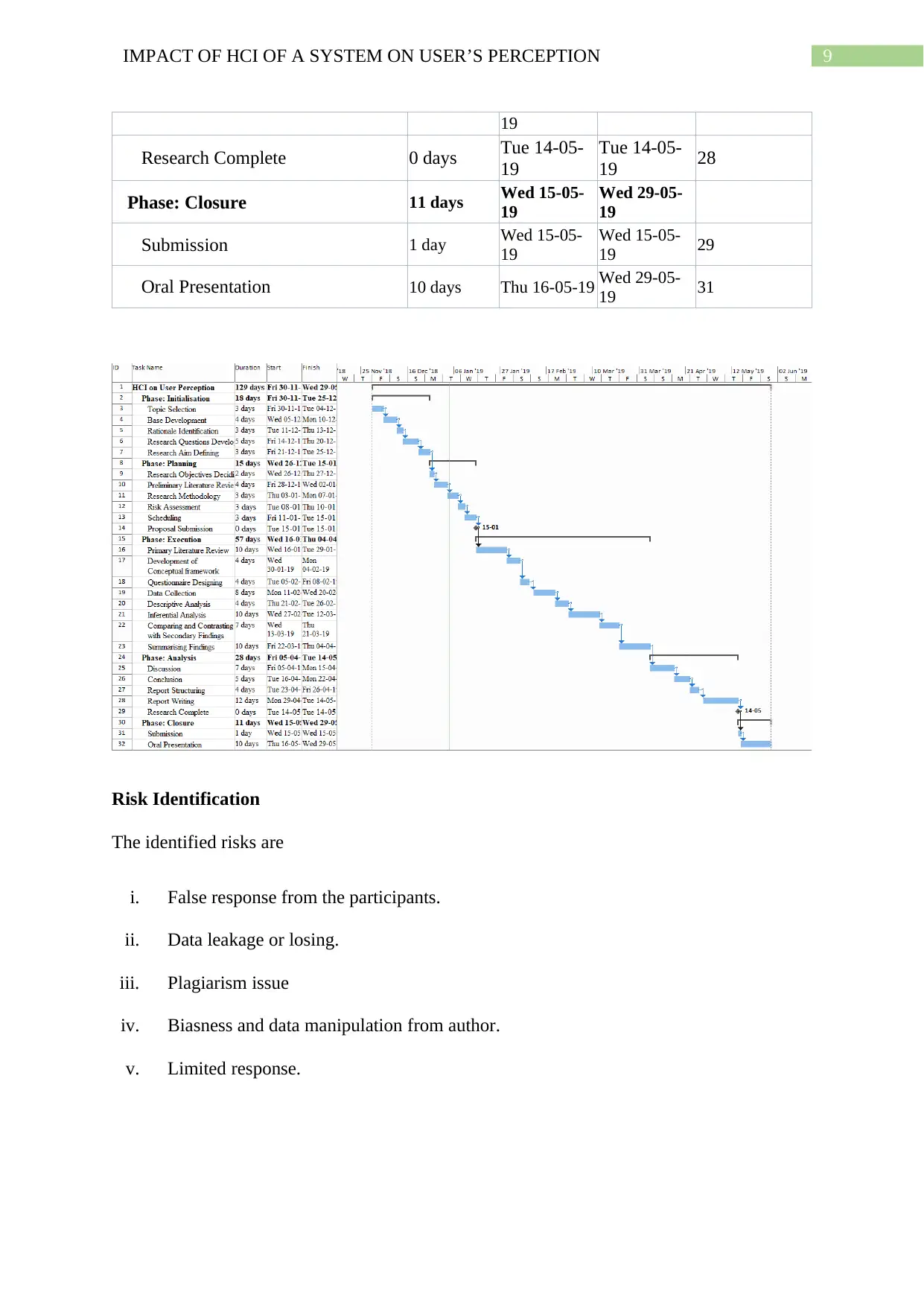
9IMPACT OF HCI OF A SYSTEM ON USER’S PERCEPTION
19
Research Complete 0 days Tue 14-05-
19
Tue 14-05-
19 28
Phase: Closure 11 days Wed 15-05-
19
Wed 29-05-
19
Submission 1 day Wed 15-05-
19
Wed 15-05-
19 29
Oral Presentation 10 days Thu 16-05-19 Wed 29-05-
19 31
Risk Identification
The identified risks are
i. False response from the participants.
ii. Data leakage or losing.
iii. Plagiarism issue
iv. Biasness and data manipulation from author.
v. Limited response.
19
Research Complete 0 days Tue 14-05-
19
Tue 14-05-
19 28
Phase: Closure 11 days Wed 15-05-
19
Wed 29-05-
19
Submission 1 day Wed 15-05-
19
Wed 15-05-
19 29
Oral Presentation 10 days Thu 16-05-19 Wed 29-05-
19 31
Risk Identification
The identified risks are
i. False response from the participants.
ii. Data leakage or losing.
iii. Plagiarism issue
iv. Biasness and data manipulation from author.
v. Limited response.
Paraphrase This Document
Need a fresh take? Get an instant paraphrase of this document with our AI Paraphraser
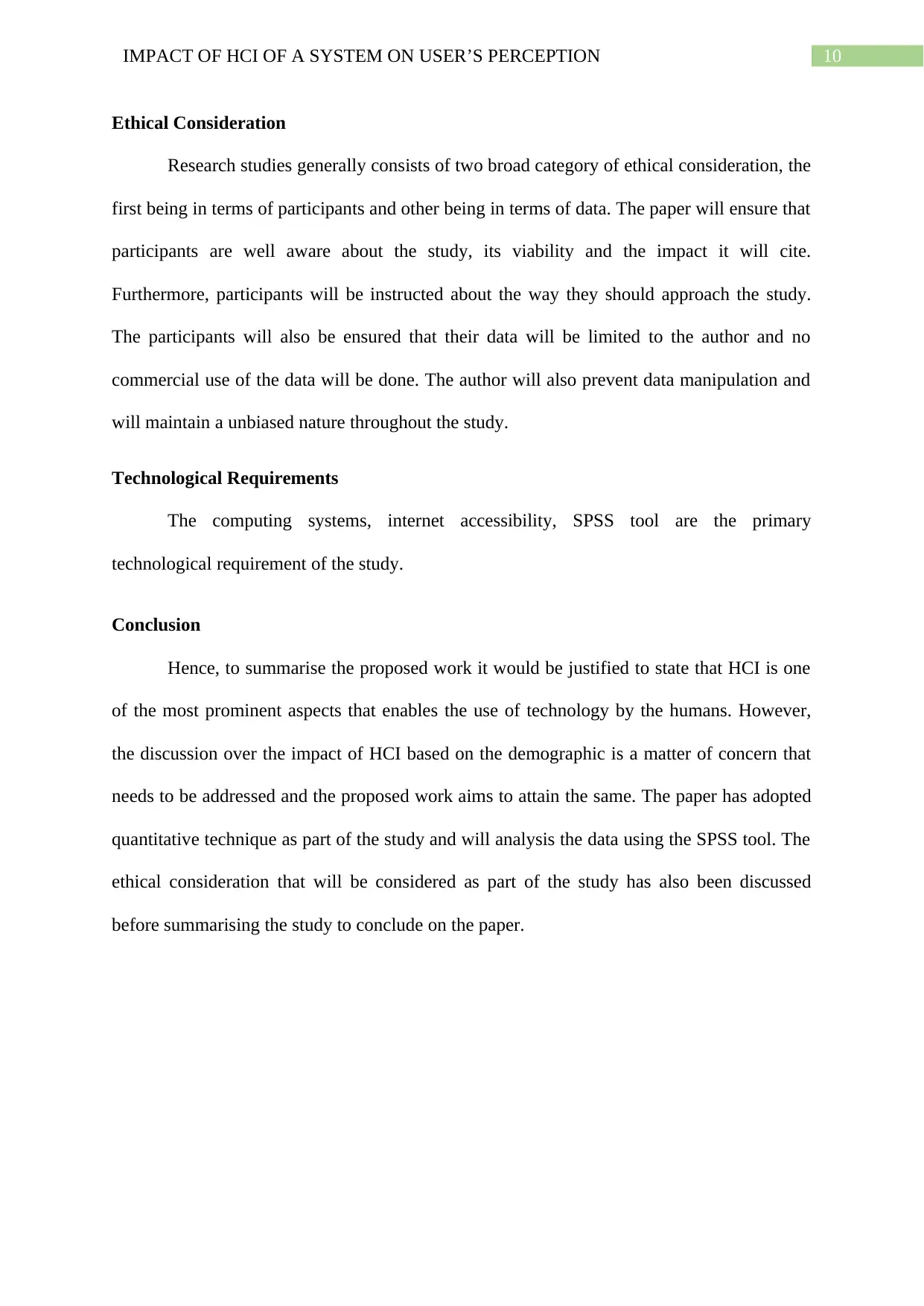
10IMPACT OF HCI OF A SYSTEM ON USER’S PERCEPTION
Ethical Consideration
Research studies generally consists of two broad category of ethical consideration, the
first being in terms of participants and other being in terms of data. The paper will ensure that
participants are well aware about the study, its viability and the impact it will cite.
Furthermore, participants will be instructed about the way they should approach the study.
The participants will also be ensured that their data will be limited to the author and no
commercial use of the data will be done. The author will also prevent data manipulation and
will maintain a unbiased nature throughout the study.
Technological Requirements
The computing systems, internet accessibility, SPSS tool are the primary
technological requirement of the study.
Conclusion
Hence, to summarise the proposed work it would be justified to state that HCI is one
of the most prominent aspects that enables the use of technology by the humans. However,
the discussion over the impact of HCI based on the demographic is a matter of concern that
needs to be addressed and the proposed work aims to attain the same. The paper has adopted
quantitative technique as part of the study and will analysis the data using the SPSS tool. The
ethical consideration that will be considered as part of the study has also been discussed
before summarising the study to conclude on the paper.
Ethical Consideration
Research studies generally consists of two broad category of ethical consideration, the
first being in terms of participants and other being in terms of data. The paper will ensure that
participants are well aware about the study, its viability and the impact it will cite.
Furthermore, participants will be instructed about the way they should approach the study.
The participants will also be ensured that their data will be limited to the author and no
commercial use of the data will be done. The author will also prevent data manipulation and
will maintain a unbiased nature throughout the study.
Technological Requirements
The computing systems, internet accessibility, SPSS tool are the primary
technological requirement of the study.
Conclusion
Hence, to summarise the proposed work it would be justified to state that HCI is one
of the most prominent aspects that enables the use of technology by the humans. However,
the discussion over the impact of HCI based on the demographic is a matter of concern that
needs to be addressed and the proposed work aims to attain the same. The paper has adopted
quantitative technique as part of the study and will analysis the data using the SPSS tool. The
ethical consideration that will be considered as part of the study has also been discussed
before summarising the study to conclude on the paper.
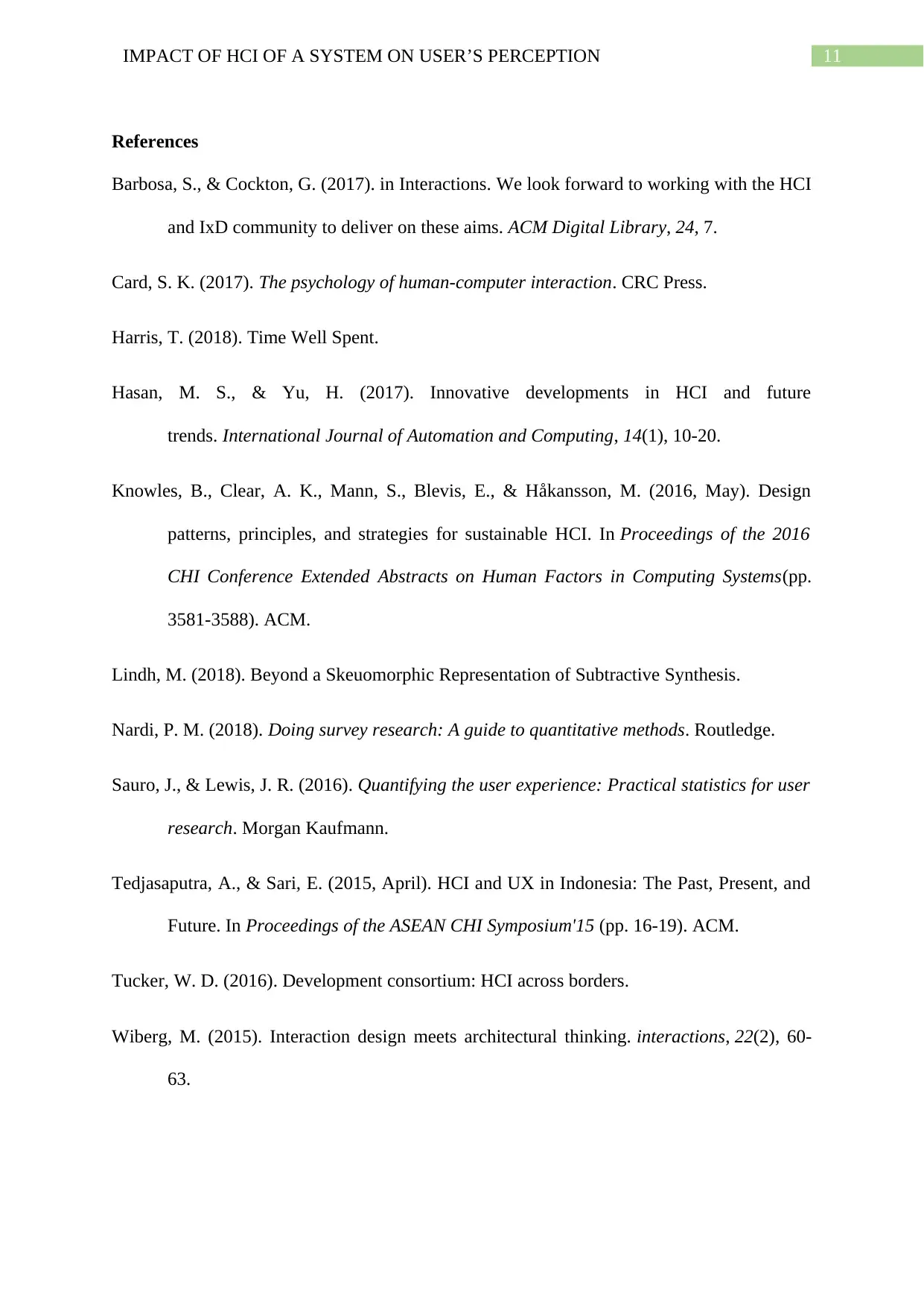
11IMPACT OF HCI OF A SYSTEM ON USER’S PERCEPTION
References
Barbosa, S., & Cockton, G. (2017). in Interactions. We look forward to working with the HCI
and IxD community to deliver on these aims. ACM Digital Library, 24, 7.
Card, S. K. (2017). The psychology of human-computer interaction. CRC Press.
Harris, T. (2018). Time Well Spent.
Hasan, M. S., & Yu, H. (2017). Innovative developments in HCI and future
trends. International Journal of Automation and Computing, 14(1), 10-20.
Knowles, B., Clear, A. K., Mann, S., Blevis, E., & Håkansson, M. (2016, May). Design
patterns, principles, and strategies for sustainable HCI. In Proceedings of the 2016
CHI Conference Extended Abstracts on Human Factors in Computing Systems(pp.
3581-3588). ACM.
Lindh, M. (2018). Beyond a Skeuomorphic Representation of Subtractive Synthesis.
Nardi, P. M. (2018). Doing survey research: A guide to quantitative methods. Routledge.
Sauro, J., & Lewis, J. R. (2016). Quantifying the user experience: Practical statistics for user
research. Morgan Kaufmann.
Tedjasaputra, A., & Sari, E. (2015, April). HCI and UX in Indonesia: The Past, Present, and
Future. In Proceedings of the ASEAN CHI Symposium'15 (pp. 16-19). ACM.
Tucker, W. D. (2016). Development consortium: HCI across borders.
Wiberg, M. (2015). Interaction design meets architectural thinking. interactions, 22(2), 60-
63.
References
Barbosa, S., & Cockton, G. (2017). in Interactions. We look forward to working with the HCI
and IxD community to deliver on these aims. ACM Digital Library, 24, 7.
Card, S. K. (2017). The psychology of human-computer interaction. CRC Press.
Harris, T. (2018). Time Well Spent.
Hasan, M. S., & Yu, H. (2017). Innovative developments in HCI and future
trends. International Journal of Automation and Computing, 14(1), 10-20.
Knowles, B., Clear, A. K., Mann, S., Blevis, E., & Håkansson, M. (2016, May). Design
patterns, principles, and strategies for sustainable HCI. In Proceedings of the 2016
CHI Conference Extended Abstracts on Human Factors in Computing Systems(pp.
3581-3588). ACM.
Lindh, M. (2018). Beyond a Skeuomorphic Representation of Subtractive Synthesis.
Nardi, P. M. (2018). Doing survey research: A guide to quantitative methods. Routledge.
Sauro, J., & Lewis, J. R. (2016). Quantifying the user experience: Practical statistics for user
research. Morgan Kaufmann.
Tedjasaputra, A., & Sari, E. (2015, April). HCI and UX in Indonesia: The Past, Present, and
Future. In Proceedings of the ASEAN CHI Symposium'15 (pp. 16-19). ACM.
Tucker, W. D. (2016). Development consortium: HCI across borders.
Wiberg, M. (2015). Interaction design meets architectural thinking. interactions, 22(2), 60-
63.
⊘ This is a preview!⊘
Do you want full access?
Subscribe today to unlock all pages.

Trusted by 1+ million students worldwide
1 out of 12
Related Documents
Your All-in-One AI-Powered Toolkit for Academic Success.
+13062052269
info@desklib.com
Available 24*7 on WhatsApp / Email
![[object Object]](/_next/static/media/star-bottom.7253800d.svg)
Unlock your academic potential
Copyright © 2020–2025 A2Z Services. All Rights Reserved. Developed and managed by ZUCOL.





